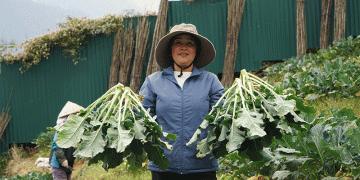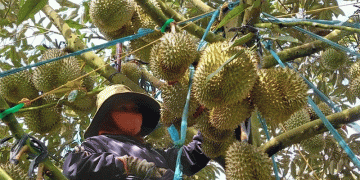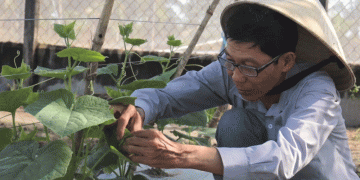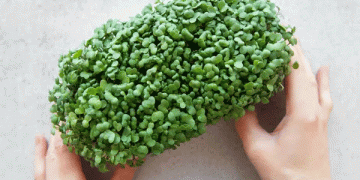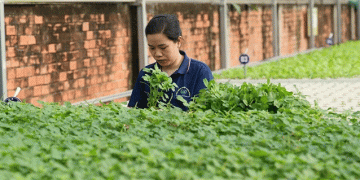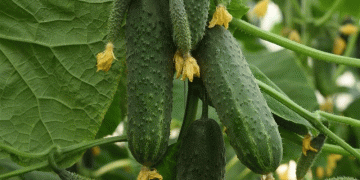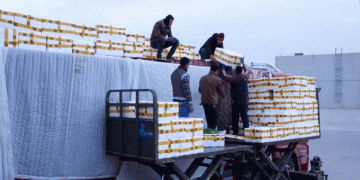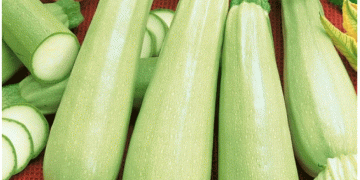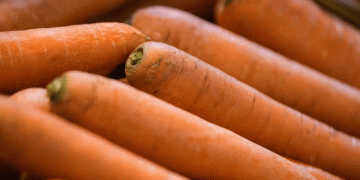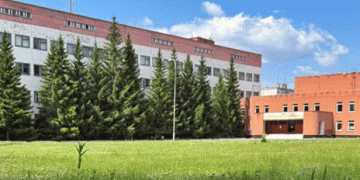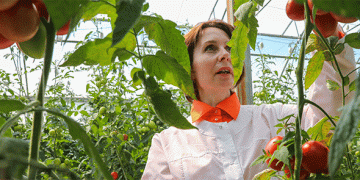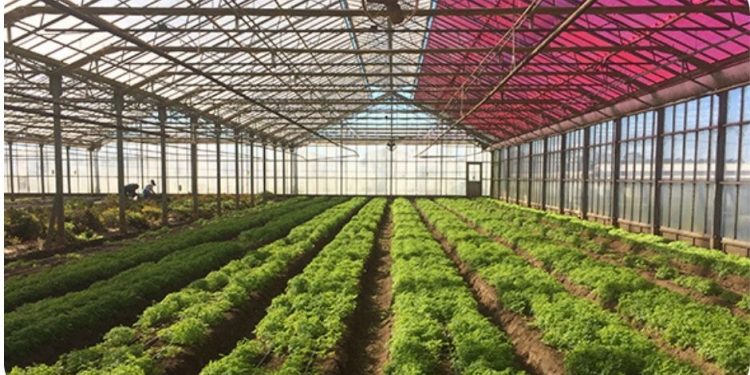A new type of commercial greenhouse panel improves light quality by amplifying colors that are beneficial to plants and generates electricity with no loss to production, according to the company that has partnered to develop the technology.
Soliculture, based in Scotts Valley, California, has completed several years of commercial plant growth trials including vegetables, ornamentals, cut flowers and berries. The company said trials have shown the panels mounted directly above crop production have neutral to positive effects on plant growth.
“Solaria has developed an industry-leading technology for manufacturing of solar PV modules optimized for greenhouse applications,” said Carley Corrado, director of business development for the company.
Solar cells, also called photovoltaic (PV) cells by scientists, convert sunlight directly into electricity. PV gets its name from the process of converting light (photons) to electricity (voltage), which is called the PV effect.
“Both plants and solar panels require sunlight, and before now it has not been possible to do both under the same roof. But, with Solaria’s proprietary technology, developed over the last decade in cutting, stringing and laminating PV cells, Solaria’s Greenhouse PV modules efficiently convert part of the sunlight into electricity while transmitting quality light for agriculture production underneath the modules,” according to a news release.
Corrado said the modules enable greenhouse growers to produce electricity for either offsetting their own power needs or enables them to generate revenue on the same existing footprint of their greenhouses, “all without compromising their agricultural productivity.”
Last summer, Fremont, California-based Solaria, a provider of solar module technologies, and Soliculture, provider of greenhouse integrated photovoltaics (GIPV) for commercial greenhouse growers, secured a strategic collaboration for PV agriculture applications.
Solaria is supplying its cell processing technology for use with Soliculture’s luminescent solar concentrator technology. The new modules are able to generate electricity in an altered light spectrum optimized for plant growth.
Technology links
Solaria’s equity investment in Soliculture allows the companies to combine their technologies to create PV solutions for greenhouse, according to the news release.
“Together, the companies have completed their first commercial project with one of the largest commercial greenhouse owners and growers in northern California,” the release stated. “The system expects to deliver a return on investment in just six years, attractive numbers for an increasingly demanding global agriculture market.”
“Solaria is excited to work with Soliculture to address two of the most pressing issues of our time – food and energy security,” said Solaria CEO Suvi Sharma. “According to the World Bank, we need to produce at least 50 percent more food by 2050 to keep up with growing populations. We are all too familiar with the critical importance of creating a more sustainable energy future. To be able to address both crop yields and climate change with one product is revolutionary.”
The two companies are using Solaria’s proprietary cell processing technology and Soliculture’s luminescent solar concentrator technology.
“Together, they offer customers a combined value of high efficiency, aesthetically attractive modules at a cost effective price with an altered light spectrum optimized for plant growth while simultaneously generating electricity,” the news release stated. “This product answers the unique needs of farmers and their businesses for a material that has neutral effects on plants but that also generates enough power to make it economically compelling. Now greenhouse growers have a major incentive to incorporating building integrated photovoltaics (BIPV) into their agriculture projects.”
“Farmers are the unrecognized heroes of our time but they will not be able to keep up with demand, increased costs and worsening growing conditions due to climate change unless we create innovations to help them,” said Glenn Alers, Soliculture’s president and CEO. “Dedicated research and years of PV experience combined have enabled Soliculture and Solaria to provide greenhouse growers with a new tool that can provide them the economic benefit of solar energy generation, along with improved agriculture production, on the same footprint. This is the future of solar, and it is now fully available for farmers to leverage incentives, save energy and save money.”
Alers said the company’s Greenhouse Integrated Photovoltaic (GIPV) panels “enable power production directly above plant growth. The greenhouse provides an ideal structure to support the panels, hence no additional racking or support is required creating an ideal location for BIPV.”
Corrado said Soliculture came together following research conduced at the University of California, Santa Cruz.
“The research was supported by grants for a number of years,” she said. “One
of our greatest challenges was slicing and dicing the solar cells to make them into thin strips. It’s a really expensive part of the process. Slicing costs more than the solar panels themselves. Solaria happened to be developing slicing and dicing technology. The machinery they have to do that is completely automated.
“(Solaria’s) technology was developed for a completely different purpose than ours,” Corrado said. “They found we had been doing research on growing plants and it allowed them access to a new market of agriculture, which was previously difficult for them. It’s a mutually beneficial partnership.”
Grower trials
Soliculture has conducted research trials with a few California greenhouse operators, including vegetable and culinary herb growers.
She said Soliculture’s first commercial trial was done in one of Stuart Kitayama’s greenhouses at Kitayama Brothers Farms in Watsonville, California.
“We rented a greenhouse and did a mixed trial of vegetables, cut flowers and ornamentals to learn the response of plants underneath the altered spectrum of our panels, compared to a control,” Corrado said. “In 2015, Stuart was the first commercial grower to purchase a greenhouse integrated photovoltaics system from us.”

Soliculture also partnered with the Van Wingerden greenhouse operation near Santa Maria, California, owned by Rene Van Wingerden and managed by his son, Ivor.
“We did a trial of our red panels in a 5,000-square-foot greenhouse to monitor the cucumber production and plant characteristics of the plants grown beneath our panels, compared to a control of cucumbers grown under a neighboring ridgeline with clear panels, in the same greenhouse,” Corrado said. “We’ve sponsored that trial. Ivor has shared resources in terms of picking data, helping us with the trial.”
“We saw that the plants under the red panels showed less signs of stress and the crop lasted longer,” Ivor Van Wingerden told Vegetable Growers News. “The system didn’t quite pencil out for us in the end, but it was very close. In the future, I’m hoping that they can make the cost per kilowatt a bit more affordable because there is a lot of potential.”
Information supplied by Soliculture said positive effects from use of the product has ranged from early crop maturation, disease resistance and longer production time. Electricity generated by the panels could offset the electricity needs of the greenhouse and other electrically sensitive equipment, like coolers, pumps and supplemental light.
Corrado said the “greatest advantage” in use of the Soliculture/Solaria product for growers “is just being able to generate power using their greenhouse as the placement for solar panels. The cost of solar has gone down so much in recent years. Solar panels themselves are a small cost. The racking and labor for installation makes up the majority of cost for solar these days. The greenhouse structure itself being able to support the structure is beneficial in reducing costs.” She said the low incremental cost of installing the panels in a new greenhouse enables a payback time shorter than a conventional solar panel approach.
Crop benefits
Other advantages of the system are specific to the crop being grown.
“In cucumbers, one of the advantages is the plants would last longer,” she said. “It goes beyond the normal three- month cycle, and the plants underneath the panel continue to grow for another week. Another advantage is disease resistance for plants underneath the panel that also benefit because you’re reducing the green light going on to the plant. It reduces the temperature going on to the plant.
“Normally, if you convert to a red light, you still get the full intensity of the green light,” but it does not bring as much damage from excess heat”, she said.
“It’s like neon when you see it in person under sunlight,” she said. “Because we’re removing a large portion of the green light, the highest intensity of the solar spectrum, you reduce the intensity of the light on (plants).”
She said lettuce crops grown under the system have “routinely had an earlier harvest time in about one-half of the varieties tested. It can bring an earlier harvest – about a week – but it depends on the variety and the conditions, of course.”
She said efforts to make the technology more mobile and cost- effective continue.
“We’re certainly interested in developing more of a crop cover of our product,” Corrado said. “Currently, it is greenhouse ready and in greenhouses now. In the future we’re looking to develop a product that would be cheaper than a greenhouse structure that would allow a grower on a large scale to continue to grow crops and put panels in, and additionally, make revenue through sale of electricity the way we’re developing our company.”
She said the system would be effective in a variety of climate settings.
“Any place that has favorable solar quality will be favorable for our product,” she said.
“It would encourage season extension in cooler environments, with similar benefits to tunnels. It provides shading while allowing the proper photosynthetic light to get through. There is a benefit to those situations where shading is necessary. It’s almost like the plants aren’t being shaded because of the light continuation. It reduces the intensity and allows plants to thrive in high light scenarios.”
She said trials as far north as Canada has shown, even in winter, when light is low, cucumber trials have yielded neutral results.
“We are confident our panels do not harm production,” Corrado said.
For more information, send an email to info@soliculture.com.















